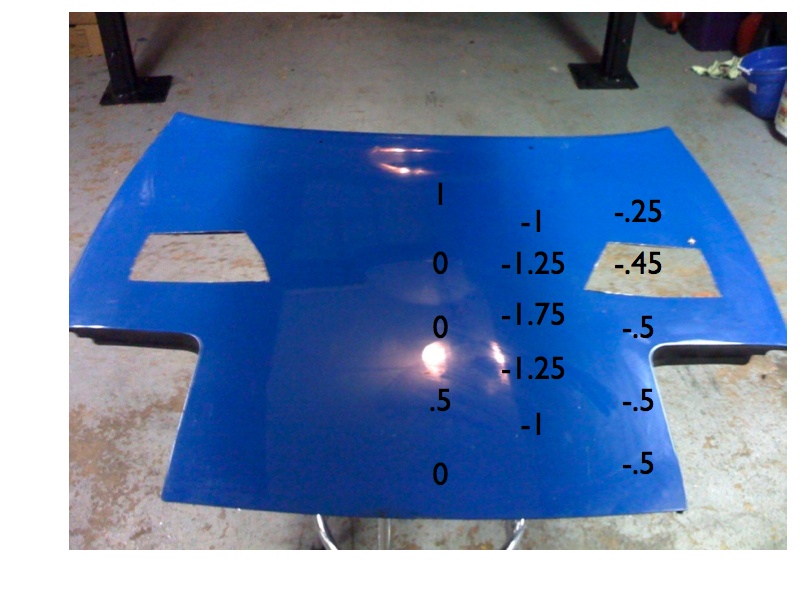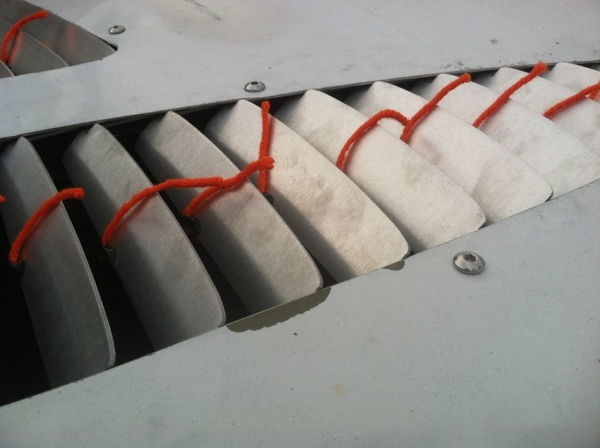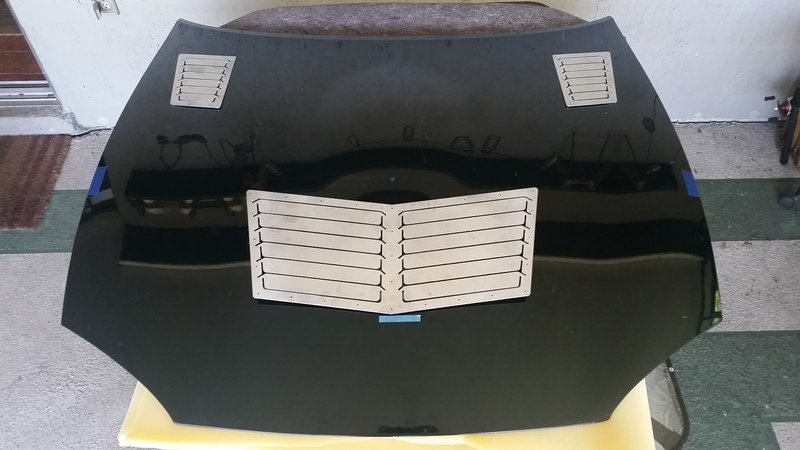Are Louvers a Good Way to Drop Engine Compartment Temps?
#3
I added mine for exactly that reason. in addition to cooling the engine bay they also seem to keep the car a little more stable at speed.
Make sure you locate them in a negative pressure area on the hood though. If you install them in a location of positive pressure you may actually be pushing air into the engine bay at speed which will compromise the radiator's ability to cool the engine and actually increase under hood temps.

-Jason
Make sure you locate them in a negative pressure area on the hood though. If you install them in a location of positive pressure you may actually be pushing air into the engine bay at speed which will compromise the radiator's ability to cool the engine and actually increase under hood temps.

-Jason
The following users liked this post:
charchri4 (05-21-2015)
#7
stole this off m.net
and there is this guy on our sister forum
I ended up putting one of the FM louvered vents on the exhaust side of my car. Why? I'm not sure but I felt the urge to do it so I did. 
I used this picture I found as a guide (negative numbers are good areas to cut).

I was careful about its placement because I didn't want it in an area that would allow rainwater to start drenching electronics since the car is parked outside. That's the main reason I didn't put one on the intake side of the hood since I couldn't find a good area.
I have no idea what it does for my under hood temperatures but, between the way water bubbles behind it in the rain and how the ice/frost thaws in the winter as I'm driving it, I do feel that it is allowing hot air out so it is doing something useful!
I'll get some pictures later when it gets lighter outside.
BB.

I used this picture I found as a guide (negative numbers are good areas to cut).

I was careful about its placement because I didn't want it in an area that would allow rainwater to start drenching electronics since the car is parked outside. That's the main reason I didn't put one on the intake side of the hood since I couldn't find a good area.
I have no idea what it does for my under hood temperatures but, between the way water bubbles behind it in the rain and how the ice/frost thaws in the winter as I'm driving it, I do feel that it is allowing hot air out so it is doing something useful!

I'll get some pictures later when it gets lighter outside.
BB.
and there is this guy on our sister forum
Alright guys, here is the culmination of our work over the last few weeks. This is a bit of a teaser with the full release and group buy coming tomorrow in a separate thread!
The percentages below are the reduction of the under-hood pressure from a stock unvented hood. A higher % change is better. By placing vents in the hood, the pressure behind the radiator is reduced, which increases the differential between the front of the radiator (very high pressure) and behind it (lower pressure). This increases the airflow through the radiator.
Reducing pressure here also reduces front end lift, which, in other words increases downforce.
Vents tested:
Basic DIY holes covered with mesh (my old hood): 13.5% pressure reduction
The hole’s simple orientation in the surface, no element forward of the vent to facilitate lower pressure over it and a mesh that impedes flow all contributed to giving this a “barely worth it” ranking.
Same DIY holes and a larger horizontal opening added between the headlights, with a gurney flap: 19% pressure reduction
The extra opening showed a better result, but the area of the opening (1.5” x 18”) limited the amount of air it can move, Vent position was the killer here, focusing just center and rearward of the radiator doesn’t utilize the best areas of the hood in terms of pressure.
GT500 vent: 27% improvement
The overall shape looks like it should be effective, but area of the openings are surprisingly small for the size of the part. Airflow is further restricted by the mesh of the GT500 vent. Coupled with very little lip forward of the opening and the same positioning issues as the options above, the GT500’s effectiveness is limited.
Autokonexion/Garage Vary composite vented hood: 31% improvement
This is a whole replacement hood. There are a lot of ‘right’ things about this one. The rear of the vent drops significantly below the hood level and a small gurney feature is shaped into the front edge of the vent creating low pressure over the vent. This hood had the largest hole area of anything we tested which made this the most effective, but we felt there was still room for improvement. We used this as our benchmark.
Singular Motorsports Hood Louver System: 49% improvement
The louver fins create a low pressure area across the entire surface of the vent. Specific fin design and the vent’s orientation on the hood are based on real-world airflow testing, Exact hole positioning based on pressure testing above and under the hood. Gurney flaps further increase efficiency. We tried multiple variations of just about every little element before deciding on the final version.
We set out to match or beat the Garage Vary hood and after wrapping up the tests yesterday, I’m very happy to report that the numbers speak for themselves: Nothing else comes close to these in terms of performance.
Group buy will be posted by tomorrow!
*pic is an unpainted prototype during testing*

The percentages below are the reduction of the under-hood pressure from a stock unvented hood. A higher % change is better. By placing vents in the hood, the pressure behind the radiator is reduced, which increases the differential between the front of the radiator (very high pressure) and behind it (lower pressure). This increases the airflow through the radiator.
Reducing pressure here also reduces front end lift, which, in other words increases downforce.
Vents tested:
Basic DIY holes covered with mesh (my old hood): 13.5% pressure reduction
The hole’s simple orientation in the surface, no element forward of the vent to facilitate lower pressure over it and a mesh that impedes flow all contributed to giving this a “barely worth it” ranking.
Same DIY holes and a larger horizontal opening added between the headlights, with a gurney flap: 19% pressure reduction
The extra opening showed a better result, but the area of the opening (1.5” x 18”) limited the amount of air it can move, Vent position was the killer here, focusing just center and rearward of the radiator doesn’t utilize the best areas of the hood in terms of pressure.
GT500 vent: 27% improvement
The overall shape looks like it should be effective, but area of the openings are surprisingly small for the size of the part. Airflow is further restricted by the mesh of the GT500 vent. Coupled with very little lip forward of the opening and the same positioning issues as the options above, the GT500’s effectiveness is limited.
Autokonexion/Garage Vary composite vented hood: 31% improvement
This is a whole replacement hood. There are a lot of ‘right’ things about this one. The rear of the vent drops significantly below the hood level and a small gurney feature is shaped into the front edge of the vent creating low pressure over the vent. This hood had the largest hole area of anything we tested which made this the most effective, but we felt there was still room for improvement. We used this as our benchmark.
Singular Motorsports Hood Louver System: 49% improvement
The louver fins create a low pressure area across the entire surface of the vent. Specific fin design and the vent’s orientation on the hood are based on real-world airflow testing, Exact hole positioning based on pressure testing above and under the hood. Gurney flaps further increase efficiency. We tried multiple variations of just about every little element before deciding on the final version.
We set out to match or beat the Garage Vary hood and after wrapping up the tests yesterday, I’m very happy to report that the numbers speak for themselves: Nothing else comes close to these in terms of performance.
Group buy will be posted by tomorrow!
*pic is an unpainted prototype during testing*
#8
In a nut shell the farther forward on the hood the better as long as you either stay behind the radiator or duct it good so you are not diverting air that should go through the radiator out of the hood vents.
If you want to see why I did what I did to mine I did quite a write up on it here Jim and Jenna build diary, Miata LS1 Conversion: LS1 V8 Miata Cooling and Hood Venting 101
If you want to see why I did what I did to mine I did quite a write up on it here Jim and Jenna build diary, Miata LS1 Conversion: LS1 V8 Miata Cooling and Hood Venting 101
Thread
Thread Starter
Forum
Replies
Last Post
jrmotorsports55
V8 Miata Chassis and Suspension
5
10-30-2014 07:35 PM
MRM331
V8 Miata Wiring, Electrical, and ECUs
0
10-13-2011 08:40 AM
Currently Active Users Viewing This Thread: 1 (0 members and 1 guests)


















